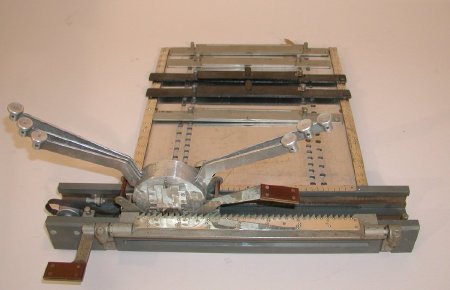Object ID:
2006.60.1
Title:
The "Crab" Braille Duplicator
Creator:
Matrix
Description:
Aluminum table pierced with two sets of columns of holes for the sliding plate holder; nickel silver plates screwed to the sides of the table number the rows of the two columns in braille (not completely consistent with American Braille), the left side numbered 1-20(interline), the right 1-27(interpoint); heavy forged steel carriage bolted to bottom of the table; aluminum writer with keys in a "crab" arrangement, three round aluminum keys on each side on long angled arms; nickel plated rulers screwed onto carriage in front and back of writer, front ruler is graded in arabic numerals 1-36, lower ruler in braille 1-36; two bakelite padded keys, front left is carriage release, key on writer is space bar; wound spring and cotton tape arrangement on left side of carriage; machine had five plate holders when found, two unpainted steel, one unpainted aluminum, and two aluminum enameled black; one of the unpainted holders is for interline, the other four are interpoint.
Dimensions:
H-6 W-16.5 D-18 inches
Date:
ca. 1968
Made by:
Coventry Gauge & Tool Company, Royal National Institute for the Blind
Place of Origin:
Coventry, England
Provenance:
Used to emboss aluminum stereotype plates by hand. "To obtain copies, the paper is inserted between the embossed folded plate which is then passed through the roller press (available separately) in between presspahn boards to afford protection to the braille characters." Based on design of RNIB's Stainsby Braillewriter, but with heavier cast iron carriage guide. Introduced originally as the "Hand Operated Machine for Embossing Aluminum Plates.
Credit Line:
APH Collection, 2006.60
